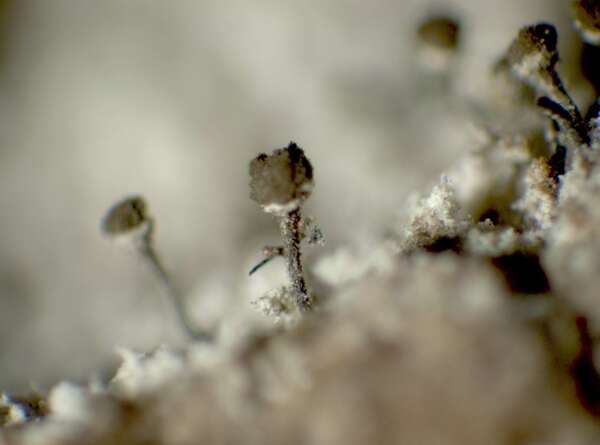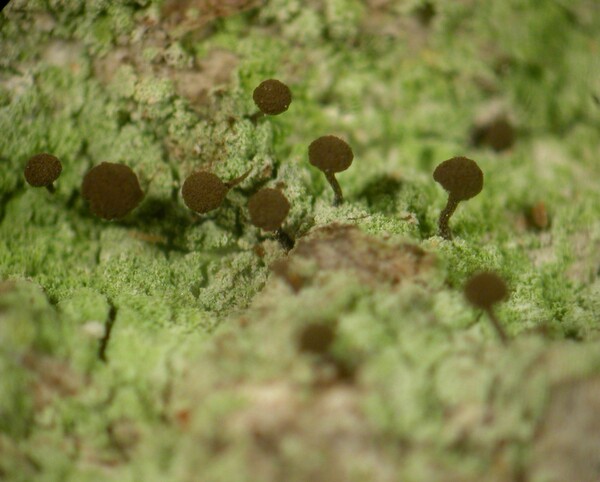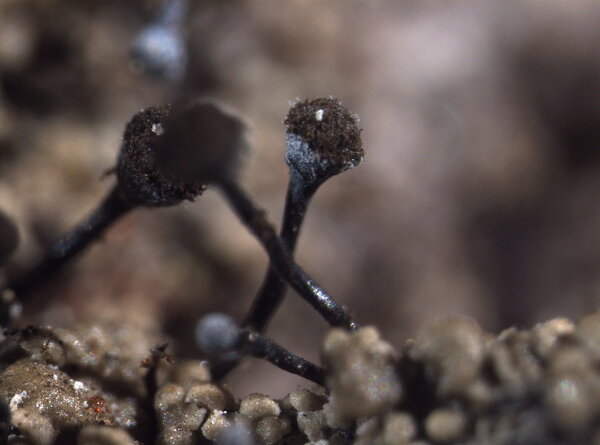Chaenotheca stemonea (Ach.) Müll. Arg.
Mém. Soc. Phys. Hist. Nat. Genève, 16: 360, 1862. Basionym: Calicium trichiale var. stemoneum Ach. - K. Vetensk-Acad. Nya Handl., 29: 283, 1808.
Synonyms: Calicium physarellum Ach.; Calicium stemoneum (Ach.) Ach.; Calicium stemoneum var. album Schaer.; Chaenotheca aeruginosa auct. non (Turner) A.L. Sm.; Cyphelium stemoneum (Ach.) De Not.
Distribution: N - Frl (Puntillo & Puntillo 2009), Ven (Nascimbene & Marini 2007, Puntillo & Puntillo 2009, Nascimbene & al. 2013b), TAA (Nascimbene 2006c, 2008b, 2014, Puntillo & Puntillo 2009, Nascimbene & al. 2007b, 2010, 2014, 2022, Nascimbene & Marini 2015, Trindade & al. 2021), Lomb (Nascimbene & al. 2006e, Puntillo & Puntillo 2009), Piem (Puntillo & Puntillo 2009), VA (Puntillo & Puntillo 2018), Lig (TSB 33550). C - Tosc (Ravera & al. 2020b), Marc (Nimis & Tretiach 1999, Puntillo & Puntillo 2009), Abr (Nascimbene & al. 2021), Mol (Puntillo & Puntillo 2009). S - Pugl (Puntillo & Puntillo 2009), Bas (CLU 2077), Cal (Puntillo & Puntillo 2009).
Description: Thallus crustose thinly episubstratic, farinose, glaucous green. Apothecia stalked, pin-like, 0.7-1.6 mm high. Stalk 0.05-0.09 mm thick, brown to black in lower part, whitish to dull brownish in upper part, of periclinally arranged, medium brown hyphae. Capitulum globose, 0.2-0.3 mm across, with a well-developed, brown mazaedium, the exciple poorly developed, forming a basal collar not visible from above; lower side of exciple paler and apparently brown-pruinose around the mazaedium, due to a hyphal web which tends to trap the brown ascospores; hypothecium brown, with a strongly convex upper surface. Asci short-cylindrical or irregular, formed in chains, dissolving early, with 1-seriately to irregularly arranged spores. Ascospores 1-celled, brown, globose, 3.5-4 µm wide, with a smooth to irregularly and thinly cracked wall. Photobiont chlorococcoid, with rectangular cells (Stichococcus). Spot tests: thallus K-, C-, KC-, P+ yellow to reddish. Chemistry: thallus with barbatic and obtusatic acids. Note: a cool-temperate to boreal-montane, circumpolar lichen found in rain-protected hollows of conifer trunks inside forests, especially near the ground, both on bark and lignum, sometimes on acid-barked deciduous trees, e.g. Betula and Quercus. Widespread, but not common. It is included in the Italian red list of epiphytic lichens under the “Least Concern” category (Nascimbene & al. 2013c).
Growth form: Crustose
Substrata: bark and lignum
Photobiont: green algae other than Trentepohlia
Reproductive strategy: mainly sexual
In underhangs rarely wetted by rain
Commonnes-rarity: (info)
Alpine belt: absent
Subalpine belt: absent
Oromediterranean belt: absent
Montane belt: rare
Submediterranean belt: extremely rare
Padanian area: absent
Humid submediterranean belt: extremely rare
Humid mediterranean belt: absent
Dry mediterranean belt: absent

Predictive model
Herbarium samples
Growth form: Crustose
Substrata: bark and lignum
Photobiont: green algae other than Trentepohlia
Reproductive strategy: mainly sexual
In underhangs rarely wetted by rain
Commonnes-rarity: (info)
Alpine belt: absent
Subalpine belt: absent
Oromediterranean belt: absent
Montane belt: rare
Submediterranean belt: extremely rare
Padanian area: absent
Humid submediterranean belt: extremely rare
Humid mediterranean belt: absent
Dry mediterranean belt: absent

Predictive model
| Herbarium samples |
 Index Fungorum
Index Fungorum
 GBIF
GBIF





